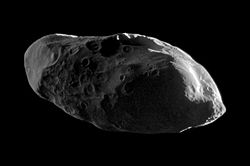Top Qs
Timeline
Chat
Perspective
Prometheus (moon)
Moon of Saturn From Wikipedia, the free encyclopedia
Remove ads
Prometheus /prəˈmiːθiːəs/ is an inner satellite of Saturn. It was discovered on 24 October 1980 from images taken by the Voyager 1 probe, and was provisionally designated S/1980 S 27.[6]
In late 1985 it was officially named after Prometheus, a Titan in Greek mythology.[7] It is also designated Saturn XVI.[8]
Prometheus is extremely elongated, measuring approximately 137 km × 81 km × 56 km (85 mi × 50 mi × 35 mi). It has several ridges and valleys and a number of impact craters of about 20 km (12 mi) diameter are visible, but it is less cratered than nearby Pandora, Epimetheus, and Janus. From its very low density and relatively high albedo, it is likely that Prometheus is a very porous icy body. There is much uncertainty in these values, however, and so this remains to be confirmed.
Remove ads
Interactions with F Ring and other moons
Prometheus is a shepherd satellite for the inner edge of Saturn's narrow F Ring. Pandora orbits just outside the F Ring, and has traditionally been viewed as an outer shepherd of the ring; however, recent studies indicate that only Prometheus contributes to the confinement of the ring.[9][10]
Images from the Cassini probe show that Prometheus's gravitational influence creates kinks and knots in the F Ring as it shepherds material from it. The orbit of Prometheus appears to be chaotic, due to a series of four 121:118 mean-motion resonances with Pandora.[11] The most appreciable changes in their orbits occur approximately every 6.2 years,[3] when the periapsis of Pandora lines up with the apoapsis of Prometheus, as they approach to within approximately 1400 km. Prometheus is itself a significant perturber of Atlas, with which it is in a 53:54 mean-longitude resonance.[3]
Remove ads
Selected images
- Prometheus pulling material from the F Ring
- Prometheus tugging kinks into the F Ring
- Voyager 2 (August 25, 1981) image
- Cassini image (with moon's Saturn-facing end at lower right) reveals a surface covered with a blanket of fine material.
- Image from Jan. 27, 2010. Saturnshine illuminates the moon's night side.
- Brightened version of same image
- Prometheus flyby
(December 6, 2015)
Animations
- Prometheus collides with the F ring, pulls a streamer, and leaves behind a dark channel. 12 seconds 107 kbit/s
- Movie of Prometheus and the F Ring looped once. 5 seconds 48 kbit/s
Notes
- Calculated from the standard gravitational parameter GM = (1.06602±0.00048)×10−2 km3·s–2 given by Lainey et al. (2023), divided by the gravitational constant G = 6.6743×10−2 km3·kg–1·s–2.[5]
References
External links
Wikiwand - on
Seamless Wikipedia browsing. On steroids.
Remove ads








